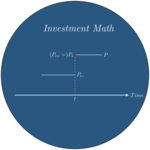Continuous Semimartingales
The previous posts introduced stochastic integration of an integrand \(H\) against an integrator \(M\) which was chosen to be a continuous martingale. Continuous semimartingales are now defined as continuous processes that can be decomposed into a continuous martingale and a continuous finite variation process. Because ‘standard’ integration theory allows to integrate against finite variation processes, one can easily extend stochastic integration from continuous martingale integrators to continuous semimartingale integrators.
As seen in this post, stochastic integration allows to integrate a predictable process \((H_{s})_{s \in [0,T]}\) against a continuous local martingale \((M_{s})_{s \in [0,T]}\).This theory requires \((H_{s})_{s \in [0,T]}\) to satisfy : \[\int_{0}^{T}H^{2}_{s}d[M]_{s}<\infty,\] almost surely.
Less exotic is the Lebesgue-Stieltjes theory of integration which says that if the continuous process \((A_{s})_{s \in [0,T]}\) has almost surely finite first order variation \(V_{A}(t,\omega)\) (see this post), it induces a positive measure \(\mu_{\omega}\) as well as a signed measure \(\nu_{\omega}\) on [0,T] (with its Borel sigma field)1. The trajectories of \((H_{s})_{s \in [0,T]}\) being measurable with respect to the Borel sigma field on \([0,T]\), they are \(\mu_{\omega}\) integrable if and only if (introducing a customary notation) :\[\int_{0}^{T}|H_{s}(\omega)|d\mu_{\omega}=\int_{0}^{T}|H_{s}(\omega)|\,|dA |_{s}(\omega)<\infty.\] When this condition is met, one writes : \[\int_{0}^{t}H_{s}(\omega)d\nu_{\omega}=\int_{0}^{t}H_{s}(\omega)dA_{s}(\omega).\] In addition, the integral as a function of time is continuous and of bounded variation.
We can thus integrate adequate predictable integrands against processes \((X_{s})_{s \in [0,T]}\) which decompose as a sum of a continuous finite variation process and a continuous local martingale. Such processes are called continuous semimartingales. Suppose : \[X_{s}=X_{0}+M_{s}+A_{s},\] where \(X_{0}\) is an \({\cal F}_{0}\)-measurable variable, \((M_{s})_{s \in [0,T]}\) is a continuous local martingale with \(M_{0}=0\) and \((A_{s})_{s \in [0,T]}\) is continuous and has almost surely finite variation on \([0,T]\), then we can define : \[\int_{0}^{t}H_{s}dX_{s}=\int_{0}^{t}H_{s}dM_{s}+\int_{0}^{t}H_{s}dA_{s},\] for predictable processes provided : \[\int_{0}^{T}H^{2}_{s}d[M]_{s}+\int_{0}^{T}|H_{s}|\,|dA |_{s}<\infty. \tag{*}\] The integral \(\int_{0}^{t}H_{s}dX_{s}\), as a function of \(t\) is a continuous process. The first integral in the decomposition \(\int_{0}^{t}H_{s}dM_{s}\) is a continuous local martingale. The second is a continuous finite variation process.
From a modelling perspective, we do not really need more than this. We can for instance allow prices to follow continuous semimartingales, and define portfolio value through a stochastic integral as explained in this post. We now know that the condition we need to impose on portfolio weights for all this to work is condition (*).
From a mathematical point of view, one can still raise other interesting questions. Given a local continuous semimartingale \((X_{s})_{s \in [0,T]}\), can we find several distinct additive decompositions of \(X\) into a continuous local martingale and a continuous finite variation process? If that was the case, we might end up with different results for \((\int_{0}^{t}H_{s}dX_{s})_{t \in [0,T]}\) for different decompositions. Such a a decomposition is unique however so that we need not worry about indeterminacy.
Another question we can raise is whether we could extend integration to a larger class of integrators. One can in effect allow for jumps both in the martingale and in the bounded variation components and define stochastic integration against general (not necessarily continuous) semimartingales2. But one could still raise the question of whether we could not extend the space of integrators even further. This question has been investigated as follows : minimal properties stochastic integration should have are specified; one then looks for a characterization of the integrator processes \((X_{s})_{s \in [0,T]}\) such that the stochastic integral of suitable predictable processes \((H_{s})_{s \in [0,T]}\) (integrands) has the specified properties. The Bichteler Dellacherie theorem (cf. Protter[2005] p. 146) spells out the required properties of the integration operation3 and the integrand space4. Under these conditions, it shows that integrators have to be semimartingales in the sense of being decomposable. Semimartingales are thus the most general processes for which stochastic integration makes sense (within the assumptions of the Bichteler Dellacherie theorem). They can equivalently be defined through the above decomposition or through the property of being a proper integrator in the sense of the Bichteler Dellacherie theorem. The latter approach is the one used in Protter[2005].
Reference : P.E. Protter[2005], Stochastic Integration and Differential Equations, Springer, 2005.
Links
The measure \(\mu_{\omega}\) ‘counts’ all the changes of \(|A|(\cdot,\omega)\) whereas \(\nu_{\omega}\) ‘counts’ the changes of \(A(\cdot,\omega)\).↩︎
A semimartingale has to be a cadlag adapted process however.↩︎
The integral should coincide with the usual definition for simple integrands, should be linear in the integrand and should satisfy some sort of dominated convergence theorem.↩︎
Integrands are assumed bounded predictable.↩︎
